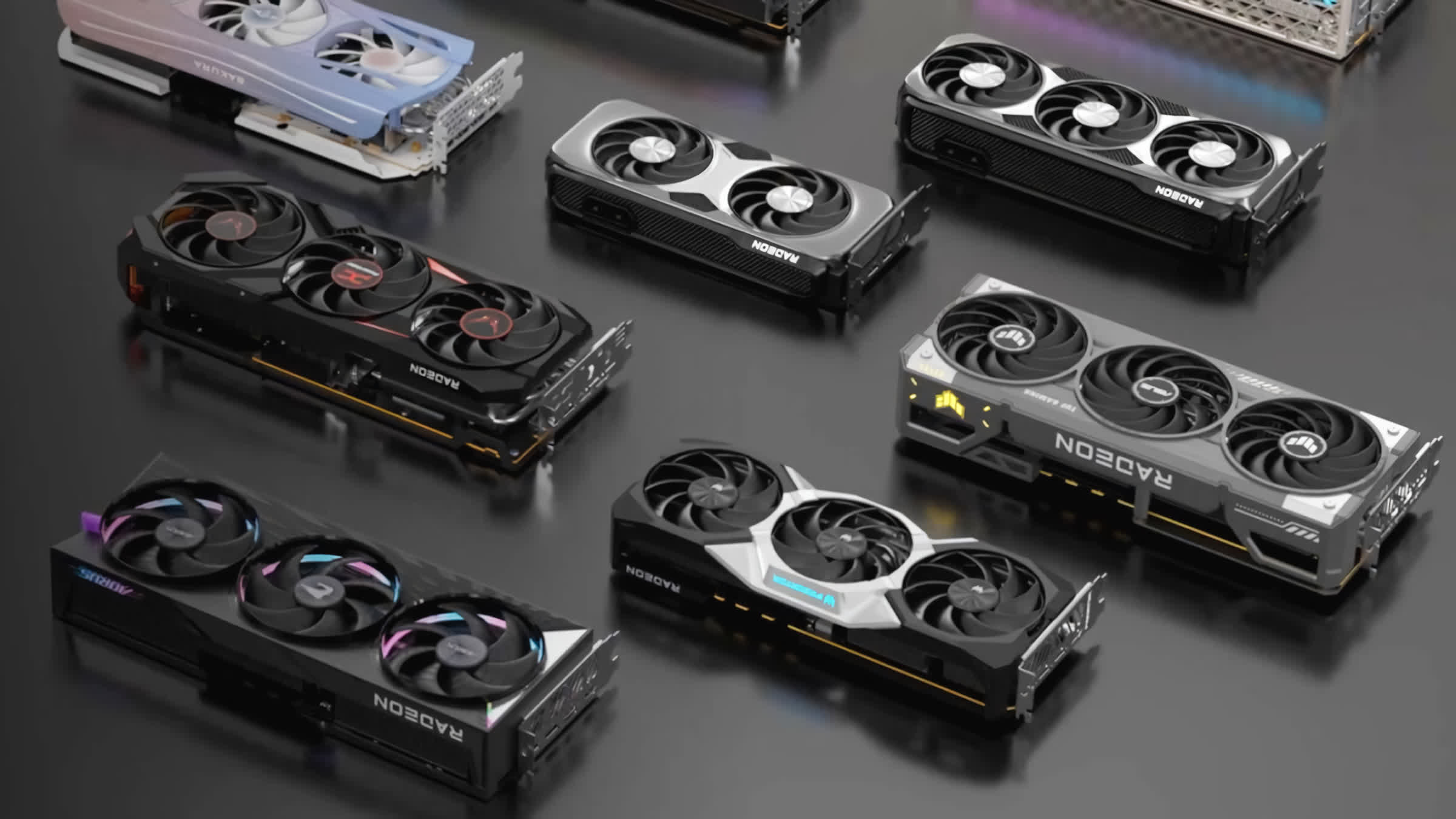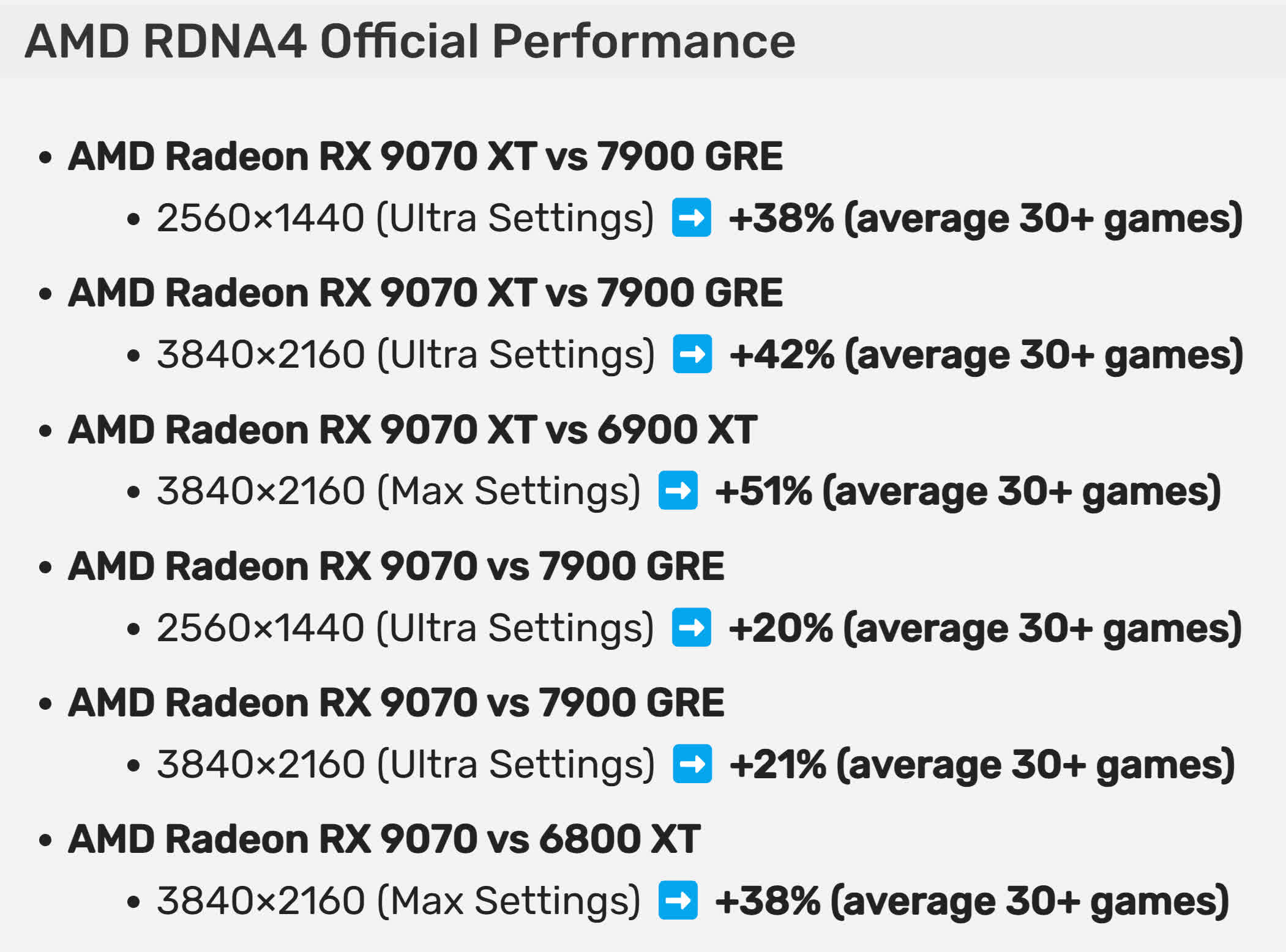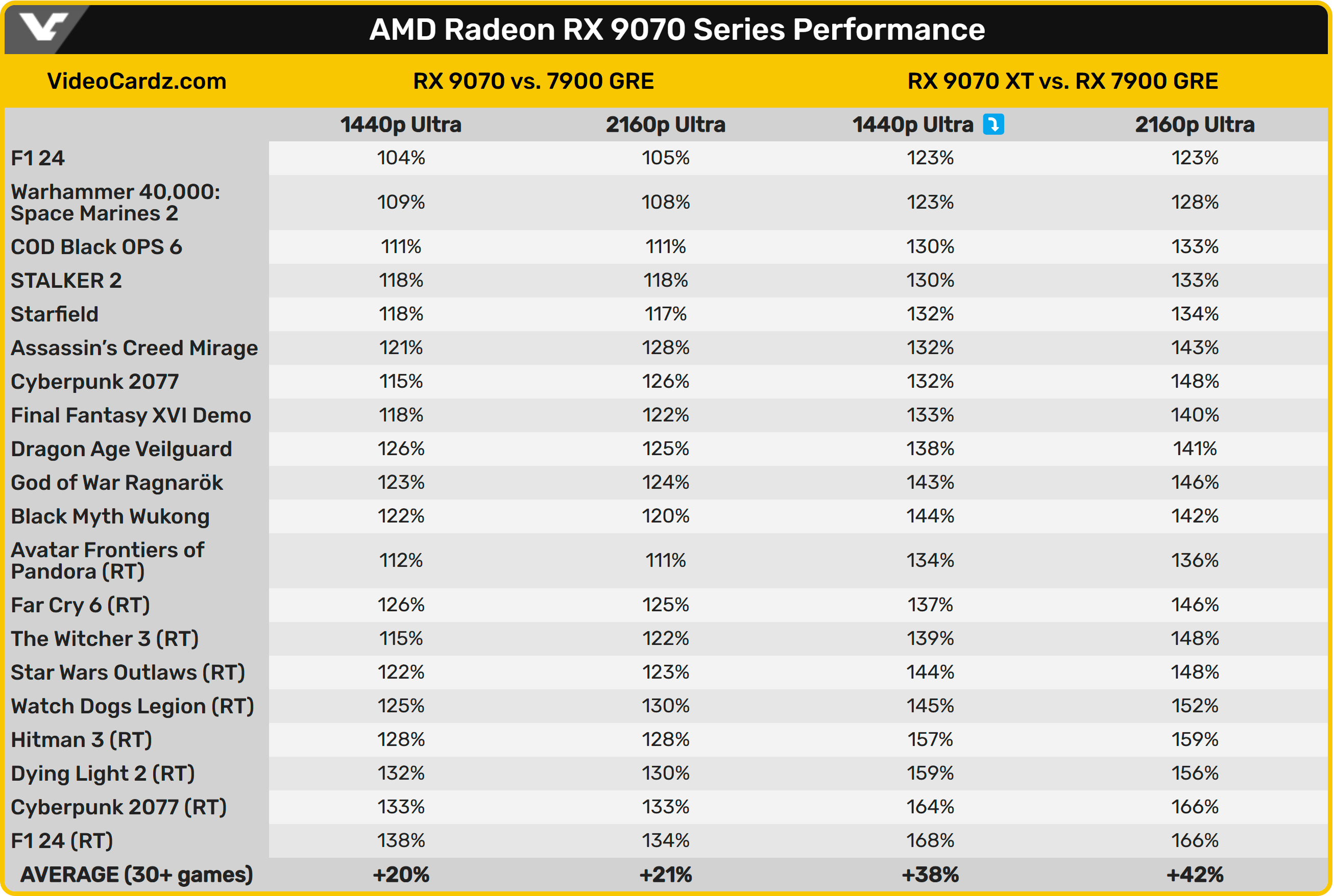Highly anticipated: AMD will officially reveal the tech specs, pricing, and launch information for the Radeon RX 9070 graphics cards on Friday. However the leaked details keep on coming, enough to get an estimate of their performance ahead of release. VideoCardz claims to have acquired the company's official benchmark charts (and now the full tech specs for both GPUs), which show performance gains in 20 games compared to the Radeon 7900 GRE.

Update (Mar 5): TechSpot's Radeon RX 9070 XT review is now live.
Update (Feb 26): Videocardz has published what they claim are AMD's confirmed specifications of the Radeon RX 9070 series, set to launch next month with the Navi 48 GPU. The Radeon RX 9070 XT features 64 RDNA 4 compute units, 64 ray accelerators, 128 AI accelerators, and 4096 stream processors, with clock speeds of 2400 MHz (game) and up to 2970 MHz (boost), delivering 48.7 TFLOPS of single-precision compute performance. The standard RX 9070 has 56 CUs, 56 ray accelerators, 112 AI cores, and 3584 stream processors, with respective lower clock speeds.
Update #2 (Feb 26): With just days before AMD's official launch, temporary listings on Micro Center (now removed) have revealed price points for the upcoming GPUs. The cheapest RX 9070 graphics card was listed at $649.99, and the most affordable RX 9070 XT appeared at $699.99, both Asrock models.
| AMD Radeon RX 9070 XT | AMD Radeon RX 9070 | |
|---|---|---|
| Architecture | RDNA 4 | RDNA 4 |
| Manufacturing Process | 4nm | 4nm |
| Transistor Count | 53.9 billion | 53.9 billion |
| Die Size | 357 mm² | 357 mm² |
| Compute Units | 64 | 56 |
| Ray Accelerators | 64 | 56 |
| AI Accelerators | 128 | 112 |
| Stream Processors | 4096 | 3584 |
| Game GPU Clock | 2400 MHz | 2070 MHz |
| Boost GPU Clock | Up to 2970 MHz | Up to 2520 MHz |
| Peak Single Precision Throughput | Up to 48.7 TFLOPS | Up to 36.1 TFLOPS |
| Peak Half Precision Throughput | Up to 97.3 TFLOPS | Up to 72.3 TFLOPS |
| Peak INT8 AI TOPS Throughput | Up to 779 TOPS w/ Sparsity | Up to 578 TOPS w/ Sparsity |
| Peak INT4 AI TOPS Throughput | Up to 1557 TOPS w/ Sparsity | Up to 1156 TOPS w/ Sparsity |
| Peak Texture Fill-Rate | Up to 730.3 GT/s | Up to 564.5 GT/s |
| Peak Pixel Fill-Rate | Up to 190.1 GP/s | Up to 161.3 GP/s |
| ROPS | 128 | 128 |
| AMD Infinity Cache | 64 MB (3rd Gen) | 64 MB (3rd Gen) |
| Memory | 16GB GDDR6 | 16GB GDDR6 |
| Memory Speed | 20 Gbps | 20 Gbps |
| Memory Bus Interface | 256-bit | 256-bit |
| PCIe Interface | PCIe 5.0 x16 | PCIe 5.0 x16 |
| Total Board Power | 304 W | 220 W |
| Recommended Power Supply | 750W | 650W |
| Display Connectors | HDMI 2.1b DisplayPort 2.1a UHBR13.5 | HDMI 2.1b DisplayPort 2.1a UHBR13.5 |
VideoCardz says that AMD expects its upcoming Radeon RX 9070 XT graphics card to outperform the 7900 GRE by about 42 percent in a mixture of raster and ray tracing 4K workloads. If the leaked internal benchmarks prove accurate, the 9070 XT and standard 9070 could trade blows with Nvidia's RTX 5070 Ti and 5070 if the price is right.
The report indicates that AMD compared its upcoming GPUs to models from prior generations in over 30 games. The tests, pictured below, utilized ultra or maximum graphics settings without upscaling or frame generation, contrasting starkly with Nvidia's methodology.

It's unclear why AMD chose the RX 7900 GRE for comparison, but it might be because it has the same amount of VRAM as the 9070 family. Against the Radeon 6900 XT, the 9070 XT's average performance advantage grows to 51 percent. Meanwhile, the standard 9070 beats the 7900 GRE by around 20 percent and outperforms the 6800 XT by 38 percent in 4K.
The benchmarked titles include games with hardware-accelerated ray tracing, such as Cyberpunk 2077 and Star Wars Outlaws, and raster-only titles like God of War Ragnarök and Starfield. Team Red also tested Cyberpunk and F1 24 with and without RT.
The new GPUs exhibit more significant gains in ray tracing than in raster performance. The RX 9070 outpaces the 7900 GRE by between four and 28 percent in raster, but the lead grows to 38 percent in RT. Similarly, the 9070 XT beats the same older card by 23 to 46 percent in raster and up to 68 percent in RT.
Click to enlarge
VideoCardz reached out to AMD, which said that it hadn't acquired RTX 5070 Ti samples for direct comparisons with Nvidia. However, a Redditor attempted to approximate one by lining AMD's averages from six games up against prior benchmarks for several of Team Green's GPUs.
Please take the results with a grain of salt. They don't incorporate FSR 4 – a critical improvement exclusive to RX 9700 – but appear optimistic for AMD. Although the 9070 XT might not match the RTX 5070 Ti in ray tracing performance, it likely outpaces every prior AMD card and matches the 5070 Ti in raster. The standard 9070 might resemble the RTX 3090's raster performance and should almost reach the 7900 XTX in RT.
Pricing is the most crucial element, but a recent leak suggests that the company's two upcoming GPUs could land between $600 and $700. They are expected to launch early next month, likely butting heads with Nvidia's standard RTX 5070. Detailed performance metrics for the $549 mid-range card remain unclear.
AMD Radeon 9070 and 9070 XT final specs and official performance benchmarks leaked
